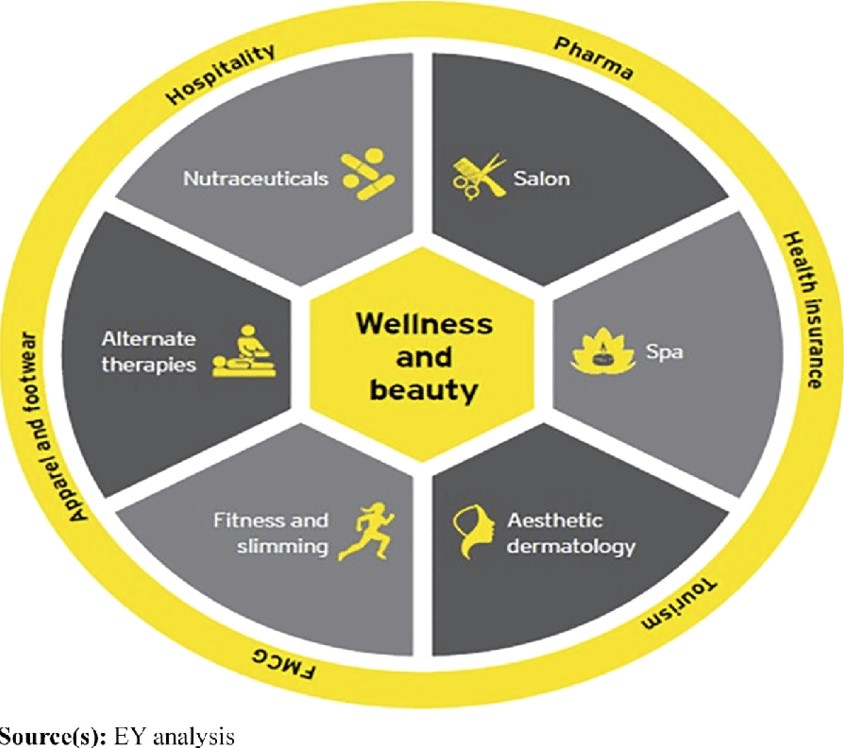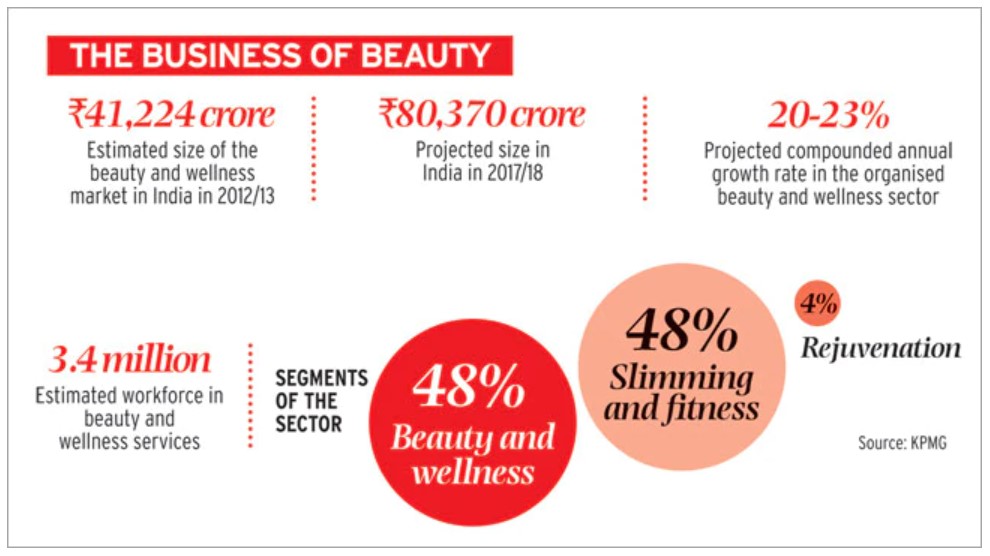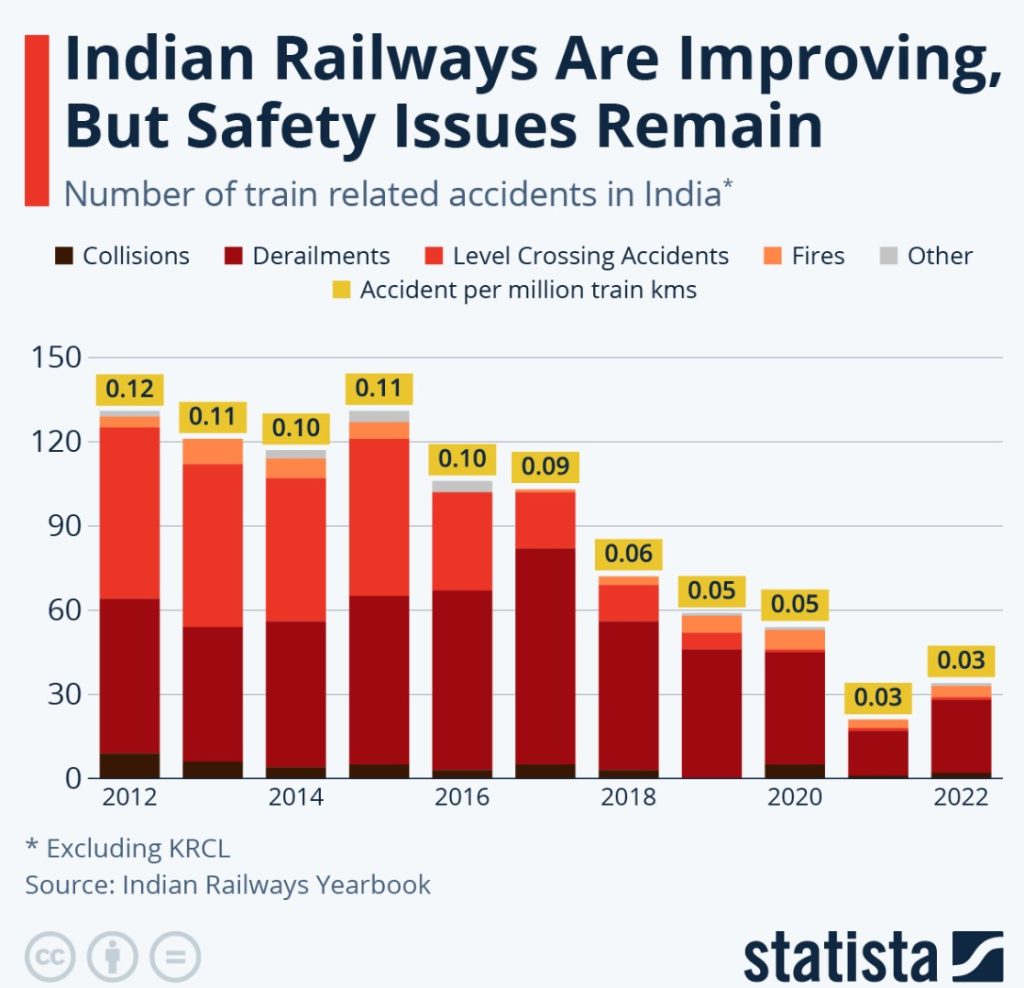CONTENTS
- Beauty-Wellness Sector is Propelling Employability
- Indian Railways and Safety Challenges
Beauty-Wellness Sector is Propelling Employability
Context:
The beauty and wellness sector offers significant potential not only for women but also for men in both domestic and international markets. The sector’s rapid growth has led to a substantial demand for semi-skilled and skilled professionals in the country. According to the India Skills Report, employability has increased by 52.8% for women and 47.2% for men. Women have outpaced men in employability, particularly in fields like nursing, beauty and wellness, and other soft skills, which have shown the highest employability rates among women in the post-COVID era.
Relevance:
GS3- Growth, Development and Employment
Mains Question:
By strategically nurturing the beauty and wellness sector sector, India can leverage its demographic advantage to create a robust workforce ready to excel both domestically and globally. Discuss. (15 Marks, 250 Words).
The Beauty and Wellness Sector:

- Currently, the beauty and wellness sector employs about 12.3 million people, with 66% of them being women, many of whom come from lower socio-economic backgrounds, as well as from well-educated families.
- By 2027, it is projected that the Indian Beauty and Wellness sector will provide employment opportunities for approximately 20.3 million people.
- Interestingly, around 44% of the workforce in the beauty and wellness sector have educational qualifications up to or below secondary education, with limited access to technical training.
- The Beauty and Wellness industry in India is growing exponentially, at a rate twice as fast as the markets in the United States and Europe.
- Increased consumer awareness and aspirations have led to higher spending on beauty and wellness products and services.

- According to the Indian Beauty & Hygiene Association (IBHA), per capita spending on beauty and personal care has increased from approximately Rs 450 per year in 2017 to Rs 684 in 2022, and is projected to reach Rs 772 in 2025.
- While the global beauty and wellness sector grew at a compound annual growth rate (CAGR) of 17.60% from 2018 to 2023, the Indian sector experienced an even higher growth rate of 18.40% during the same period, driven by a growing affluent and middle-class population and an increased presence of organized retail.
- The sector is expected to reach about Rs 2,77,000 crores by 2025, marking a 23% growth from Rs 92,000 crores in 2018.
Potential Areas of Growth:
Vocational Education:
- There are opportunities for greater integration of vocational education, especially in areas such as salon services, beauty, fitness, nutrition, and yoga, where there is increasing acceptance of vocational training.
- Additionally, the rising demand for services like nutrition consulting, fitness coaching, and nutraceuticals has created new and diverse career opportunities for young people who need skill enhancement and vocational education in the Beauty and Wellness field.
Promoting Female Entrepreneurship:
- Promoting female entrepreneurship in India is crucial, as currently, only about one in five entrepreneurs are women. The beauty and wellness sector offers unparalleled opportunities for women’s employment and entrepreneurship.
- Hence, there is an urgent need to actively encourage entrepreneurship and self-employment for women in this sector through specialized entrepreneurship education, training programs, and financial support to help them grow their businesses.
- To support female entrepreneurs, it is essential to create a dedicated fund in collaboration with the NSDC, industries, and angel investors to foster innovative start-ups in the sector.
- Additionally, establishing regional incubation centers is vital to spark the entrepreneurial spirit of promising women in the industry.
- This initiative should equip young female entrepreneurs in the beauty and wellness industry with advanced business management skills to successfully manage their enterprises.
- This targeted effort will help female entrepreneurs develop viable business ideas, create investable business plans, and formulate strong business growth strategies.
Digital Transformation:
- The beauty and wellness sector is undergoing digital transformation as technology-led startups and 5G network access in rural areas become more common.
- Consequently, traditional skills in this sector need to be updated with knowledge of new-age technologies such as app setup, virtual try-on services, and data analytics to enhance customer engagement.
- Moreover, artificial intelligence (AI) is making significant advances in the beauty and wellness industry. AI innovations like augmented reality are rapidly changing the sector.
- For instance, AI-powered skin consultations analyze skin aging, detect major signs of aging, and offer personalized skincare recommendations by combining thousands of images with decades of dermatological expertise.
- Personalized services have become increasingly important due to changing customer preferences, lifestyles, body types, and genetics. The one-size-fits-all approach is obsolete, as customers now seek unique and tailored experiences.
Conclusion:
The demand for on-demand at-home services has surged, particularly among busy professionals, highlighting the need for transferable skills among workers in the sector. Additionally, new ideas and processes are motivating young students to pursue technical and technological careers, aiming to shape a better future. In terms of skill development, taking action, maintaining consistency, and sticking to a routine are essential. Leveraging demographic advantages requires serious planning and isn’t just a trivial task. It involves building capacity, developing infrastructure, and training our young population to equip them with the skills needed for employment both locally and internationally.
Indian Railways and Safety Challenges
Context:
The dust has yet to settle following the tragic accident involving the GFCJ container train, which, while traveling at high speed, collided with the 13174 Agartala-Sealdah Kanchanjunga Express. This incident resulted in 11 deaths and approximately 40 injuries. Amid the uproar, it is crucial to examine some key points.
Relevance:
- GS2- Government Policies and Interventions
- GS3- Infrastructure
Mains Question:
In the context of rising train accidents in India, analyse the causes behind such incidents. What can be done apart from resource allocation to deal with the issue? (10 Marks, 150 Words).

Is the Lack of Resources a Cause of Railway Accidents?
- Focused measures such as closing unmanned level crossings and prioritizing track maintenance have indeed improved the safety record of Indian Railways in terms of fatalities and injuries.
- However, comparing current data to past records to present an overly positive outlook is misleading.
- Modern systems and tools make achieving a zero-fatality record an attainable goal, which the Railways should aim for.
- Moreover, the Union government’s significant investment, allocating nearly 25% of its total capital expenditure to railways, means funding all necessary safety works is within reach. The lack of resources can no longer be used as an excuse.
- A statutory inquiry by the Commissioner of Railway Safety (CRS) is underway to determine the cause and responsibility for the accident.
- It is almost certain that the crew of the GFCJ container train, the station master, and possibly the signal maintainer will be held responsible for ignoring the stipulated Automatic Signal territory protocol.
- This pattern of blaming lower-level functionaries recurs with each serious accident.
Additional Issues that Need Attention:
Information Management and Communication System:
- There are additional issues that may or may not be routine but deserve more attention. First, the information management and communication of Indian Railways need scrutiny.
- While facts about the accident were still emerging, the Chairperson of the Railway Board prematurely blamed the container train crew’s disregard for signals as the primary cause.
Implementation of Kavach:
- When questioned about the slow deployment of an indigenous signaling system designed to prevent collisions, she attributed it to limited capacity within the supporting industry. If industrial capacity is insufficient, Indian Railways must support and encourage the allied industry with substantial assurances to facilitate investment in capacity building.
- Indian Railways chose the Kavach system nearly three years ago after extensive trials over 1,400 kilometers on the Southern Central Railway, opting for it over the established European ETCS Level II system.
- The project has been ongoing since then, and the slow progress suggests a lack of focus on safety works.
- If Indian Railways remains uncertain about Kavach’s effectiveness or the speed of its implementation, there is no harm in installing ETCS Level II in some key sections while Kavach is further developed.
- We have heard that Kavach is being implemented on the Delhi-Howrah and Delhi-Mumbai sections, but the target completion dates have been missed.
- It is important to consider two recommendations from the CRS report on last year’s Vizianagaram train accident.
- The report emphasized prioritizing the implementation of Kavach in Automatic Signalling territories, which are prone to collisions, and suggested faster installation in locomotives and trains before ground installations to increase the likelihood of preventing collisions.
- The Railways should focus on trunk routes and Automatic Signalling territories for faster Kavach installation, aiming for 4,000 to 5,000 km per year, which is achievable.
Views on the Existing Protocol:
- There are differing opinions on the protocol for station masters and crews in the event of an Automatic signal failure.
- The CRS report criticized this issue, highlighting poorly drafted rules that create ambiguity during Automatic signal failures. Indian Railways, like many government entities, is overstaffed.
- However, certain safety-critical categories, such as loco crew, train managers, station masters, pointsmen, and signal maintainers, require continuous work. Any vacancies in these roles cause stress and overwork for existing staff.
- Maintaining such vacancies to save costs is counterproductive. Despite nearly 20,000 vacancies for loco pilot/assistant loco pilot positions, Indian Railways issued a notice to recruit only 5,658 positions earlier this year.
- After strong criticism following this accident, this was revised to 18,799 positions, clearly indicating a careless handling of an important issue.
Lack of Action in Employing AI:
- A related issue is the lack of action in employing AI-enabled applications to enhance safety analyses and provide actionable alerts.
- AI can effectively manage extensive digital data from station data loggers and microprocessors on locomotives and trains, filtering out minor irregularities to highlight major issues and regularly presenting them to top railway management.
Conclusion:
A significant question is whether the accident was an isolated incident or if similar near misses are common in the affected section. If the inquiry reveals that such incidents were indeed frequent, it would indicate a serious management failure. It is hoped that the inquiry report will focus more on managerial issues this time, paving the way for a clear path toward a safe, accident-free Indian Railways.




